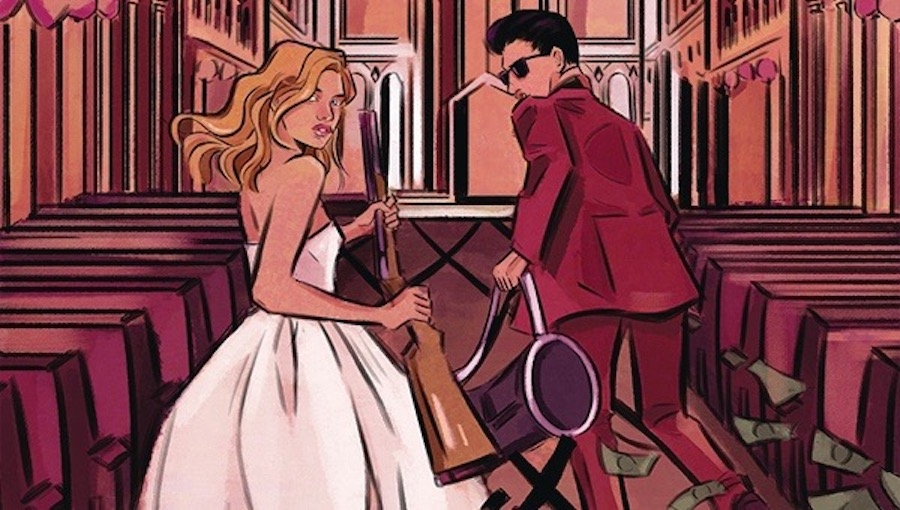As we enter the third issue, we’re treated to Stockholm syndrome at work, with the Bad Elvis Gang eating cake and teaching kids how to handle a shotgun. (The best.) Emily is still an indecisive mess, Jesse is trying to be the supportive fiancée, and Grandma Harriet just drugged one of the gang members and is about to go to town with a shotgun – all of this while the sheriff is preparing for the worst with 15 pounds of plastic explosives rigged to explode and Twitter blowing up with hashtag, #mooreemilymooreproblems.
The issue begins with another flashback to Emily and Tom, and we can tell that Emily was practically in heaven with him. I don’t know if it’s an archetype or a cliché at this point, but Emily being the rich kid feeling caged until she meets a stranger isn’t necessarily who she is. We come to understand this through the frustration of this entire event, and not just the hostage situation (although that’s not actually helping much either). Emily is stuck in a situation that she doesn’t want to be in, and that’s reflected in the kidnapping situation going on in her wedding. Her inner turmoil of wanting to be with her family (as horrible as they are) and running away with the gruff and dangerous outlaw (who is a criminal and will forever be running or in a cage) seems to be the driving force of all that is happening.
I think one of the unintended consequences of the story is the way it’s making Emily appear to the reader. I can’t get a grasp of whether she’s selfish or selfless, and it kind of has to do with the fact that she’s juxtaposed against Jesse, a character who didn’t readily appear to be such a capable character. One thing I didn’t expect was to fall in love with the character of Jesse, the unfortunately noble and loving groom to be. Looking back throughout the entirety of the story, I didn’t realize how likeable a person he had become. He’s a man thrust into the most unfortunate of circumstances on a day that’s supposed to be his happiest. He’s the most relatable character, and the one I’ve been finding myself rooting for the most (even more than Emily) which begs the question: Why should we care about someone who clearly doesn’t want anything to do with what is essentially a perfect cinnamon roll of a character (he’s just so nice and loving, no on deserves him).
Sometimes, the depiction of violence in stories make us forget about the price of taking a human life. In Going to the Chapel, everything is played up for laughs until we’re reminded that this is a hostage situation and that there are real stakes at play. While the story could have spent a little more time dwelling on the reality of the situation, this isn’t the gritty and hard-hitting drama that Pepose’s previous series, Spencer & Locke, was, but I think that the story could have included a bit more of the realism.
The consistency of the art throughout the series is something that should be lauded. Three issues in, and the art still feels fresh and consistent. I feel as though every single character can be a real person, and that has to do with the linework, coloring, and overall art direction. It’s honestly one of the most artistically consistent stories I’ve read in a while, and that’s saying something.
Nevertheless, as with all good things, the end is in sight. With one more issue left, I can’t wait to see how all of this is going to wrap up, especially since Pepose and his team have such an amazing way of closing out the chapters of their stories.
Creative Team: David Pepose (writer); Gavin Guidry (art); Liz Kramer (colors); Ariana Maher (letters)
Publisher: Action Lab: Danger Zone
Click here to purchase.

